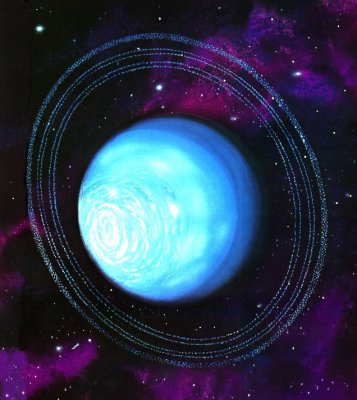 Saturn has the most complex ring system in the solar system while Jupiter and Neptune have faint and simple rings. Uranus rings may not be as extensive as Saturn’s but it is more complex compared to Jupiter’s and Neptune’s. The Uranus rings were first observed more than 2 centuries ago by British astronomer William Herschel. Modern scientists argue whether Herschel actually saw the rings using the available technology at the time because the rings of Uranus are very faint and dark.
Saturn has the most complex ring system in the solar system while Jupiter and Neptune have faint and simple rings. Uranus rings may not be as extensive as Saturn’s but it is more complex compared to Jupiter’s and Neptune’s. The Uranus rings were first observed more than 2 centuries ago by British astronomer William Herschel. Modern scientists argue whether Herschel actually saw the rings using the available technology at the time because the rings of Uranus are very faint and dark.
It was in 1977 that astronomers confirmed the existence of Uranus rings through the discovery of Edward Dunham, James Elliot and Douglas Mink. After more than a decade, two more rings were discovered by the Voyager 2 spacecraft. In 2003 and 2005, two more rings were observed by the Hubble Space Telescope. To date, there are 13 rings to Uranus.
Unlike other ring systems that were given proper names, Greek letters were primarily used to name the rings of Uranus, particularly the main rings.
- ε ring (epsilon) – Is the brightest and the densest of the 13 rings of Uranus. It is also highly reflective, responsible for more than half of the reflect light by Uranus’s rings. The exact thickness of the ε ring is unknown, but astronomers estimate it to be around 150 meters.
- δ ring (delta) – Has an optically thin but dense component and a geometrically broad component with low optical depth. It was proven in 2007 when the ring exhibited increased brightness that can only happen under those conditions.
- γ ring (gamma) – It is a narrow ring with a width of about 4 kilometers only. In 2007, the γ ring was not seen during a plane-crossing event, which led to the conclusion that it is geometrically thin but it is optically dense.
- η ring (eta) – Has components that resemble the delta ring. It was evident during the plane-crossing event in 2007 when the η ring became the 2nd brightest ring.
- α and β rings (alpha and beta) – These two rings are second only to the ε ring in terms of brightness. These two rings disappeared in 2007 indicating the lack of dust and properties resembling the γ ring.
- Rings 6, 5 and 4 – Are the narrowest and darkest of the Uranus rings. Due to this property, these rings were not visible during 2007.
